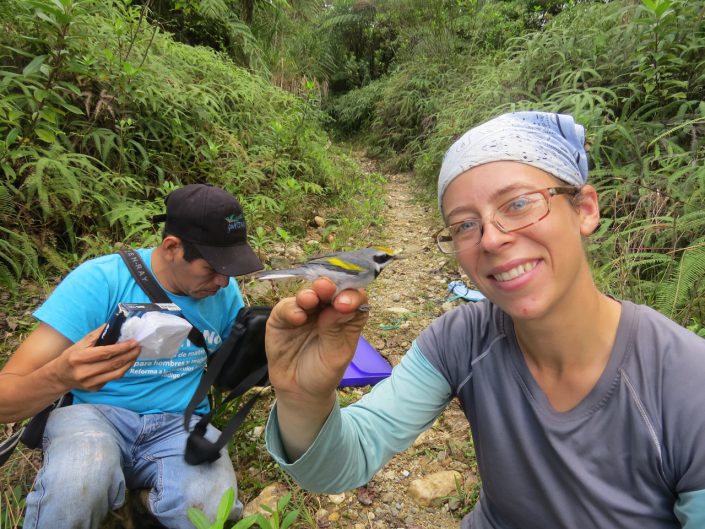Connecting the Life Cycle of a Golden-winged Warbler
A Closer Look at Cutting-Edge Research on the Multi-Country, Migratory Life-Cycle of GWWA
by Kelly Triece, Private Lands Biologist

While in Honduras this February 2016, I had the opportunity to meet researchers studying the Golden-winged Warbler (GWWA) in their wintering habitat. The GWWA is Neotropical Migrant songbird that breeds in New Jersey, but migrates south for the winter. Golden-winged Warblers migrate south in September, mainly through a corridor of states east of the Mississippi River and west of the Appalachians. Their peak return migration to the Upper Mid-west and Appalachians, including New Jersey, occurs in late April where they find a mate, breed and rear their young.
This neo-tropical songbird is a species of special conservation concern in the U.S. and endangered in New Jersey, experiencing population declines due to loss of young forest habitat on their breeding grounds, habitat loss on their wintering grounds and hybridization with the Blue-winged Warbler (BWWA). The GWWA has experienced one of the steepest population declines of any songbird species in North America. The population size of the GWWA has decreased by an average of 2.6% every year, according to the USGS Breeding Bird Survey, since the survey began in 1966. In particular, the Appalachian populations are now approaching a rate of -9% per year. Due to the difficulty of tracking birds over large distances, the effects of their multi-country, migratory life-cycle are poorly understood.

While many songbirds, migrate thousands of miles every winter, most research has focused on their breeding habitat in North America. Recently, researchers have begun exploring and understanding the importance of conserving the entire life-cycle of migratory birds or any wildlife species. Ruth Bennett, a Ph.D student at Cornell University is one such scientist. Ruth and collaborators at the American Bird Conservancy and Indiana University of Pennsylvania are linking breeding and non-breeding Golden-winged Warbler populations through geolocator technology. Ruth is also studying how changes in land use that lead to habitat loss on the wintering grounds of the GWWA are linked to population declines, with support from the US Fish and Wildlife Service Region 3.

Ruth Bennett, P.h.D. student, aims to connect the wintering habitat of the GWWA and its breeding habitat through her research in Central America. Between November 1, 2015 and March 15, 2016, Ruth and collaborators deployed geolocators on 145 GWWA and 35 BWWA at 9 sites from Belize through Panama, including Honduras. She will then recapture the individuals next winter, 2016-2017. These geolocators supply location data for up to 12 months, giving insight into the full life-cycle of the Golden-winged Warbler and closely-related Blue-winged warblers (BWWA). Through this research she will be able to establish the migratory pathways for all recaptured individuals. She will be able to compare how habitat loss on their wintering grounds and land use changes correlate with population trends described on the breeding grounds.
This will be one of the first geolocator studies to establish the connectivity of a migratory species from a winter grounds origin. This research is important, because it creates a connection between non-profit, local and state governments in the United States and those in Latin America. This may increase funding opportunities and increase the efficiency of conservation action taken on the winter grounds. This research is especially important, as it forms one of the core informational components of the Golden-winged Warbler Non-breeding Season Conservation Plan (currently in review, soon to be available at gwwa.org). The conservation plan provides a regional strategy for conserving Golden-winged Warbler wintering habitat based on the wintering ecology of this species. The plan furthermore outlines conservation projects and budgets within high priority wintering focal areas that have been developed by Latin American partners. Ongoing research will be critical to ensure that these conservation actions effectively conserve the non-breeding habitat of this declining species.

Ruth has a small crew of local biologists who assist in her research in Latin America. Through her research in Honduras and Central America, Ruth has been able to connect with many local biologists and conservationists. It was great to meet Ruth in Honduras and learn about her research, which so important to New Jersey, but taking place so far away.
Our next Honduras blog, will feature our time with Ruth at the Feria de Aves Migratorias (Migratory Bird Festival) at the Universidad de las Agricultureal (Agriculture University) in Olancho, Honduras!
Learn More:
- “Bird Friendly” Brew: Honduran Shade-Grown Coffee
- CWF Headed to Honduras to Study Golden-winged Warbler
- Conserve Wildlife Foundation’s online field guide: Golden-winged Warbler
Kelly Triece is the Private Lands Biologist for Conserve Wildlife Foundation of New Jersey.
Discover more from Conserve Wildlife Foundation of NJ
Subscribe to get the latest posts sent to your email.